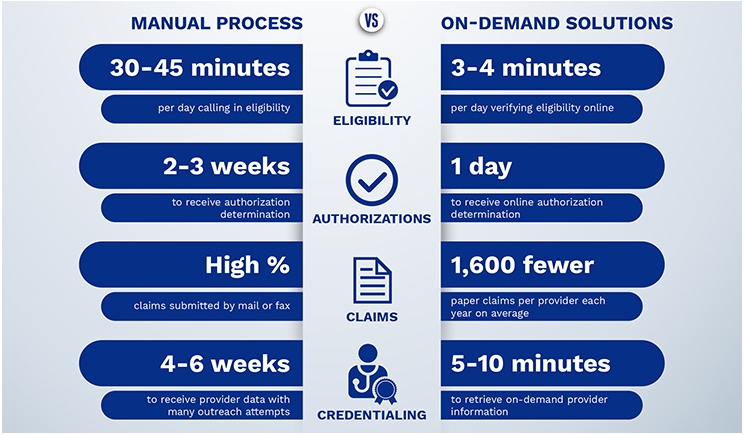
In the wake of the coronavirus pandemic and subsequent social distancing measures implemented nationwide, dental service providers—especially smaller practices or those just starting out—are facing more challenges than ever.
Cashflow is an especially big concern for providers operating on margins that have been under pressure from practice closures and reduced patient numbers. Many dental practices have also reduced the number of their administrative staff or have been forced to allow greater flexibility for staff to work from home.
Thus, dental administrators have more to do and are under greater pressure to ensure an ideal outcome. Getting the provider paid for dental services and keeping patients returning in the future is more challenging when administrators may not have all of the means to process claims and payments as before.
The situation has further exposed the inefficiencies and higher costs of having to file claims traditionally through an insurance payer clearinghouse. Since the absolute most critical, time-sensitive step is payment, electronic payment adoption is increasing, and we have seen a steady rise in the usage of electronic payment web portals and applications during this time.
This is actually a continuation of the trending adoption of electronic claims submission and online payment processing that had been steadily rising since before the pandemic. Today, usage of electronic claims submission by dental providers nationwide is in the high 90th percentile.
More recently, we have found that since the beginning of 2020:
- Payees accepting direct deposits increased 32%.
- Electronic remittances increased 19%.
- Electronic authorizations increased 6.5%.
A Single Source of Truth
Across the dental payer industry in general, it’s a huge challenge establishing accuracy in provider data and records, identifying and correcting errors and maintaining one provider, one record, and one source of truth.
This has a direct impact on a provider’s ability to predict reimbursement income and also reduce claim delay and denial rates. More accuracy leads to quicker payments and more time to focus on administering quality, value-based care.
To validate this, the most common reasons claims are denied or delayed include
- Incorrect or missing patient information
- Invalid or inaccurate current dental terminology (CDT) codes
- Incorrect or incomplete submissions, such as a missing tooth number, lost x-rays, or a performed but non-covered service
- Duplicate claims filed
- Failure to confirm eligibility prior to treatment
- Failure to request pre-authorization or requesting pre-authorization when not required
Quite simply, by using electronic web-based payment portals, providers can reduce the incorrect, unclear, or missing information, which mitigates both claim delays and denials, minimizes administrative costs, and ensures a smooth revenue cycle.
Payment portals use real-time application programming interfaces (APIs) so clearing houses and providers on the network can connect to the adjudication system and run claims and pre-determinations through the entire editing and adjudications process online. Modern systems can check and calculate all business and payment rules and return a response in seconds.
An electronic system should provide a response that is not simply an estimate, but also an accurate calculation of what the provider will be paid so providers can determine what to collect from their patient before the patient leaves their office. They can charge patients for those services that are the patient’s responsibility on the spot, and they don’t need to chase a patient later for the payment that is due.
Providers no longer need to be concerned regarding uncovered expenses or out of pocket expenses, enabling them to have better revenue cycle management. Dental procedures can be planned and paid for with more speed and accuracy than ever before.
Members also benefit from the speed and accuracy that electronic web-based payment portals deliver, because they will understand the cost of care upfront, which can lead to better retention.
The Future of Dental Payments—Watch This Space!
Future electronic payment methods on the horizon for dental service providers include virtual cards and e-cheques.
By further enabling providers to transact electronically, dental office managers and administrators will continue to gain added efficiencies and smarter methods to predict and adjudicate payments and thereby improve cashflow, reduce consumer bad debt, streamline administration, and eliminate costly errors.
Online payment and claims processing is also second nature to the newer generation of dental providers and office administrators entering the workforce—mostly millennials who are “electronic” out of the gate.
These new recruits will continue the use of payer web portals and further increase efficiency by enabling an automated, more accurate, and paperless provider relationship with payers.
Mr. Tetzlaff is the vice president of dental benefits management at SKYGEN USA with more than 20 years of experience in managing government and commercial healthcare and dental plans. He can be reached at marcel.tetzlaff@skygenusa.com or (262)-946-4453.
Related Articles
Three Tech Trends Shaking Up the Dental Landscape in 2020
How Dental Providers Can Overcome Billing Challenges
Reputation Management Starts With the Revenue Cycle











